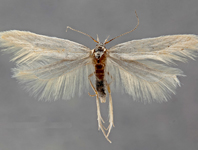Abstract
Dichagyris is a diverse genus with a Holarctic distribution. Only a few taxa of the subgenus Albocosta Fibiger & Lafontaine, 1997 occur in the northwesternmost part of the Oriental region. The genus is most diverse in Turkey, Iran and the Central Asiatic high mountains. However, there is a distinct Sino-Tibetan group of species, possibly representing an undescribed subgenus. However, this idea is provisional and awaits revision of the genus. For present purposes, we assign these species to the subgenus Dichagyris. They share the following putative synapomorphies: black, dark brown or dark greyish forewing ground colour (with one exception), with obscure, reduced wing pattern and a broad-based, short, conical harpe in the male genitalia. Species of this group can be subdivided to two species-groups. In the astigmata-group which was mentioned for the first time by Hreblay et al. (1998) but without description or diagnosis from the minuta-group, the vesica is elongate and tubular (males), the appendix bursae and corpus bursae are long, sack–like, almost equal in size (females). In the minuta-group, the vesica is more ample than in the astigmata-group, and coiled, and the appendix bursae is globular and much shorter than the corpus bursae. The astigmata-group includes Dichagyris astigmata (Hampson, 1906), D. gansuensis Hreblay & Ronkay, 1998, D. geochroides (Boursin, 1948) and D. vargazoli (Gyulai & Ronkay, 2001). The minuta-group comprises D. minuta Hreblay & Plante, 1998 and D. kormos Gyulai & Ronkay, 2001. During a research expedition in Sichuan in 2019, the existence of a third species in the minuta-group was recognized, which is described here. In addition, the female and its genitalia of D. gansuensis, which was described by Hreblay & Ronkay (1998) based on a single male, are illustrated here for the first time.
References
Chen, Y.X. (1982) Two new species of Agrotinae from China. Acta Entomologica Sinica, 25 (2), 199–200.
Boursin, Ch. (1948) Neue palaearktische Agrotis–Arten aus dem Naturhistorischen Museum in Wien nebst Synonymie–Notizen. (Beiträge zur Kenntnis der “Agrotidae–Trifinae”, XLIV). Zeitschrift der Wiener Entomologischen Gesellschaft, 33, 97–136. [in German]
Gyulai, P. & Ronkay, L. (2001) The Noctuidae material collected by Peter Gyulai and Adrienne Garai in the Qinghai region, China, 1999 (Lepidoptera). Esperiana, 8, 655–700.
Hreblay, M., Ronkay, L. & Plante, J. (1998) Contribution to the Noctuidae fauna of Tibet and the adjacent regions. A systematic survey of the Tibetan Noctuidae fauna based on the material of the Schäfer–expedition (1938–1939) and recent expeditions (1993–1997). Esperiana, 6, 69–184.
Hampson, G.F. (1906) Catalogue of the Lepidoptera Phalaenae in the British Museum. Vol. 6. British Museum Trustees, Taylor and Francis, London, 532 pp.
Lederer, J. (1857) Die Noctuinen Europa’s, mit Zuziehung einiger bisher mesit dazu gezählter Arten des Asiatischen Russland’s, Kleinasien’s, Syrien’s, und Labrador’s. Friedrich Manz, Wien, 251 pp. [in German]
https://doi.org/10.5962/bhl.title.60460


